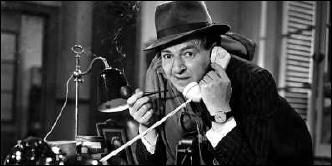Tue 1 Dec 2009
Reviewed by David L. Vineyard: GEORGES SIMENON – Maigret and the Enigmatic Lett.
Posted by Steve under Characters , Reviews[2] Comments
GEORGES SIMENON – Maigret and the Enigmatic Lett.
First published as The Strange Case of Peter the Lett: Hurst, UK. hardcover, 1933. First US edition: Covici Friede, hardcover, 1933. Translation of “Pietr-le-Letton” (Fayard: Paris, 1931). Also published as: Maigret and the Enigmatic Lett, Penguin, pb, 1963.

Then standing with his back to the stove, he filled a pipe, and tugged at his shirt collar; it was a low one, but felt too tight.
And so we meet Jules Maigret in his too small office in the Quai des Orfevres, a large and deliberate man who always seems a little outside of his environment, a little uncomfortable in it.
The first of Maigret’s cases finds the good Commissar at the top of his game. Pietr the Lett is an international criminal that Interpol identifies as headed for Paris. Maigret heads for the train station at the Gare du Nord to intercept Pietr only to find a man fitting his description dead in the train toilet.
Inside the dead man’s pocket Maigret finds a photograph and a lock of red hair. Maigret and his man Torrence lunch at the Brasserie Dauphine behind the Place de Justice for the first time and discuss the case. It will become a familiar scene. Is Pietr dead, or two men — or more? Soon a virtual army of Pietr’s aliases present themselves.

With the help of the police lab at Quai de Orfevres, Maigret is lead to a couple, the Mortimer-Levinson’s, staying at the Hotel Majestic, millionaires and friends of one Oswald Oppington, and he follows the trail of one Olaf Swann, a Norwegian merchant marine officer to Mme Bertha Swann living in Fecamp.
Maigret has his man Torrence posted at the hotel and he travels to Fecamp where he follows a Russian, Fedor Yurovich, a Russian drunk, back from Mme Swann’s to the Jewish Quarter of Paris where he is living with a dancer, Anna Gorskin, physical age 25, but with a much older and more tarnished soul:
For the first time we see Maigret in his familiar form, cold, wet, and tired, even his famous pipe wet watching the goings and comings of the criminal classes. He is watching and waiting. He is biding his time, and soon he will act. But only when the time is right.
Later Maigret is wounded while following the Mortimer-Levinson’s from a night club. He rushes to the Hotel Majestic to find Torrence murdered, both attacks the work of the dancer Anna Gorskin.
Now Maigret tightens his web in the pursuit of the Lett, who has re-emerged, and finally tracks down the killer, revealing the mystery of the enigmatic criminal known as Pietr the Lett. Maigret, taking a note from the classical detective novel, allows the defendant an easy out.
He drank slowly. Or rather he pretended to drink. He was holding his breath.
At last the report came. He drained the glass at one gulp.
And then he goes home to Mme Maigret. Until the next case.

From the beginning Maigret is something different. The writing is controlled and succinct. There is little extra verbiage, and Maigret himself is not given to colorful action or dress. He is a drab policeman enshrouded in a fog of pipe smoke, sipping Calvados, a beer, or a glass of Pernod at some small brassierie, steady, patient, and as inevitable as the dawn as he moves forward toward the truth through the lies, self delusion, and human frailties of the men and women he must investigate and pursue.
But unless the criminal is a soulless brute, a kind of intimacy almost always grows up.
This is the famous method of Maigret, the gradual cajoling, bullying, empathizing with the suspect as he uncovers the truth one layer at a time.
This is Maigret as Hemingway first encountered him, writing as Sim or sometimes Simenon, a Belgian journalist whose stories flowed from his pen in seeming endless progression growing darker, deeper, and more psychologically complex as time passes.
The Maigret novels invite us into a world that is at once familiar and foreign. Like Holmes’s London or Chandler’s L.A., Maigret’s Paris is a living place, a character itself, and realized so deftly that though in the background it is ever present in our unconscious mind.
But few debuts in crime fiction are as assured and complete as this one, and the remarkable thing is that it is the same voice and the same character we will know so much more about some eighty books later. Maigret, unlike many great fictional characters, comes to life fully formed sprung from the forehead of Simenon complete and instantly recognizable.

Few great detectives emerge so fully imagined on their first outing. For most there are stumbles, missteps, false starts. But Maigret, pipe puffing away, is here, as always, one with his world and ours, patiently nursing a glass of Calvados, his pipe smoke curling about him, his overcoat a bit too heavy for the weather, his great mind waiting to leap upon the truth, his great soul ready to embrace the frailties of the human beings he must deal with on a daily basis. This, too, is the method of Maigret.
Note: While I don’t think this book was adapted as one of the Maigret films. it was adapted as as an episode of at least three of the many international television series based on the character, including the best known British series with Rupert Davies (see above).
December 2nd, 2009 at 6:35 pm
I’ve neglected Inspector Maigret badly over the years, and review/essays like this only convince me all the more what a dunderhead I’ve been.
I don’t know if I own this one, but being Maigret’s first case, if I can find a copy, I think I might as well start with number one.
Incidentally, David, I obviously also don’t know much about the various TV adaptations of the Maigret stories, but if I’ve correctly identified Rupert Davies in the photo I used in the post above, all I can say is that he looks NOTHING like the Inspector Maigret I have pictured in my mind’s eye.
— Steve
December 2nd, 2009 at 8:23 pm
Davies grew into the role of Maigret over a fairly long run, and a quite large number of actors have played the role from Charles Laughton and Richard Harris to Jean Gabin (probably the best) and Michael Gambon. The longest running German television Maigret was very popular and nothing at all like the character in the books, so it isn’t always the physical character that matters.
The long running Davies series was much loved and extremely popular, and often cited as one of the best incarnations of the character on screen.
Davies also played another major series character. He appears briefly as George Smiley in The Spy Who Came in From the Cold with Richard Burton.
Re Maigret it may take one or two to get into the swing of things, but you can pretty much jump in anywhere. For all their literary merits — which are considerable — they are also entertaining, and odd to say comfortable.
You find yourself drawn to Maigret’s world the way you sometimes return to Sherlock Holmes or Father Brown not just to be entertained but as if you are returning home.
It sounds a bit strange, but there is something very reassuring about reading Maigret and visiting his cold wet somewhat grimy Paris. It’s is very close to the feeling you get in Holmes foggy London where it is always 1895. Maigret and his world are a timeless place that you may well find addictive.
In any case he is the most human of the great detectives, perhaps the only one you would really feel comfortable having a drink with in some small brasserie in Paris. That in itself is a major accomplishment. Most of the great sleuths are great creations, but not really human beings — Maigret is above all massively human.